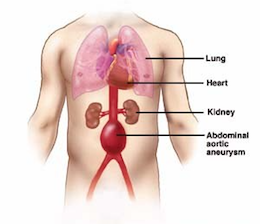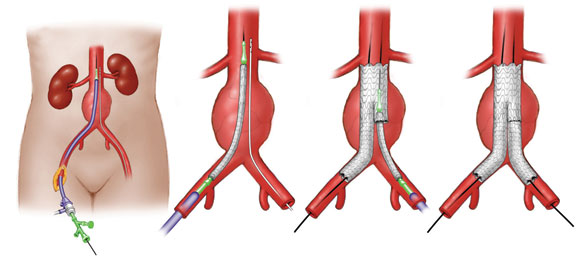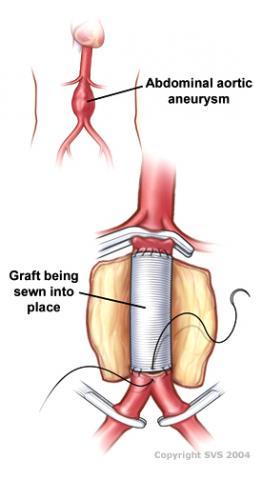Have you had a scan and been told you have an Abdominal Aortic Aneurysm?
This can be a very frightening experience but don’t worry, I can talk you through what we need to do next. Do make an appointment to see me to discuss it. However, if you want some further information about aneurysms, please see the description of the disease below.
What is an Aortic Aneurysm?

The Aorta is the major artery carrying blood from the heart to the rest of the body. In the abdomen, the aorta has branches to the main organs: liver, spleen, kidneys and guts. It then divides at the level of the tummy button to supply the legs. If the aorta becomes dilated, it is called an aneurysm. The commonest place for this is in the lowest segment before the aorta divides to supply the legs
Aortic Aneurysms usually occur in men aged 60 and over. They are less common in women. Aneurysms are more common in people who smoke and have high blood pressure. There can be a family history of the condition. As the aorta dilates the wall of the aorta is stretched and becomes thinner. This can lead to the wall tearing leading to internal bleeding. This is called an Aneurysm Rupture. Sometimes clot forms within the aneurysm and this can cause problems with the circulation to the legs.
How do I know if I have an Aneurysm (AAA)?
All men aged 65 are now invited to have an ultrasound examination to pick up their aneurysm early. However, the majority of AAA’s cause no symptoms so can be discovered by chance. An examination by your GP or a scan performed for another reason may pick up the AAA. Some patients are aware of a prominent pulsation in the abdomen. Rarely, the AAA may cause some back pain and abdominal pain.
What is the chance of my AAA rupturing?
The chance of rupture is very low for small AAAs. For aneurysms measuring less than 5.5cm in diameter, the risk of rupture is less than 1 in 100 per year. As aneurysms get larger than 5.5cm, the risk of rupture increases and it is usually at this size that the option of surgery is considered.
Should everyone with an AAA have surgery?
The short answer is no. Surgical repair of an AAA is a major operation and carries risks. Research has shown that for people with aneurysms, measuring less than 5.5cms (about 2 inches), it is safer not to operate as the risks of having an operation are greater than the benefit.
Surveillance of small AAAs
If your aneurysm is smaller than the size at which operation is needed, I will arrange for you to have regular ultrasound scans (usually every 6 to 12 months) to monitor the rate of growth. Most aneurysms grow slowly at a rate of about 3mm (1/8th inch) per year but larger aneurysms can grow more quickly. How often you will need to have a scan will depend on the size of your aneurysm. Your blood pressure will be checked and you will be given advice about managing your risk factors and staying healthy.
Surgery will be recommended when your aneurysm grows to 5.5cm, or appears to be growing rapidly between scans. Sometimes, people get back pain or tenderness over the aneurysm. These symptoms can be a sign that the wall is being stretched and you should seek advice urgently.
Treatment Options for AAAs.
Once your aneurysm reaches 5.5cm, you will be assessed for your fitness for surgery. Assuming you are fit for surgery, you will be offered treatment.

EVAR repair
The majority of aneurysms are repaired using the endovascular technique. Two small cuts over the groins allow us pass a device up the artery from the groin and to place a new inner lining across the stretched segment of the aorta. This is all done under X-ray control. Although this is relatively straightforward, it is still a complex procedure with its own risks and complications.
Open repair
This is a major surgical procedure so we reserve this for younger fitter patients with a long life expectancy.

Medical Treatment
If you are unfit for surgery, you can doctor reduce the chance of your AAA rupturing by taking care to control your blood pressure.
If you are to have surgery in the future, it is a good idea to make sure that you are as well as possible. Ask you GP to check your cholesterol and to monitor your blood pressure. It is also a good idea to have a full cardiac check up. Regular moderate exercise can also help keep your heart and lungs healthy.